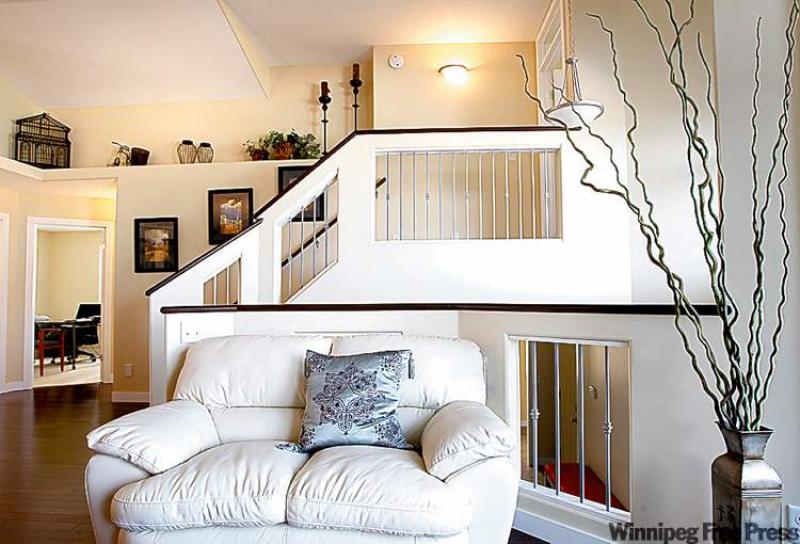New Homes
New Homes
MHBA plays key role in workers' safety
The Manitoba Home Builders' Association supports a culture of occupational safety and health to make the province's residential construction sector safer for its workers.
The MHBA Workplace Safety and Health Committee, established in 2002, plays a key role in promoting safety and health for its members. This committee works with the province's Workplace Safety and Health Division and the Construction Safety Association of Manitoba to develop training and education, highlighting safety on work sites.
In addition to participating in Manitoba's annual construction safety conference, the MHBA co-ordinates a two-day housing forum each year. Last year, members heard presentations on topics such as safety audits, loss prevention, fire safety and H1N1 awareness.
The MHBA also offers a subcontractor safety course that outlines the importance of safety on site, educates building sub-contractors and trades on their responsibilities as employers and explains how to conduct a hazard assessment, inspection and toolbox talk.
Fall protection is one of the association's most important training programs. To that end, the Fall Protection Training Centre was established. This facility reflects real-life working conditions and provides practical training to workers in the trades on using fall-protection systems.
Because residential construction in Manitoba continues to experience active growth, effective measures for safety and health must be created and used on every job site. In 2008, following a key focus of its workplace safety and health committee, the MHBA board of directors mandated that all builder members must have a certified safety program, such as the Certificate of Recognition (COR). Now, more than 70 per cent of all new homes built in Manitoba are constructed by companies that are safety certified.
The Manitoba Home Builders' Association and its member builders continue to promote safety on the work site for the betterment of the industry, the client and the worker. Safety is good business.
Mike Moore is president of the Manitoba Home Builders' Association.
New Homes
Imagine; legislation that is actually a deal
POSSIBLY the best piece of legislation to come from the federal government in decades has been the Home Renovation Tax Credit.
Introduced in the 2009-10 budget, the HRTC was designed to stimulate the economy in a time of recession. The basic premise was that the consumer would receive a rebate on their taxes if they renovated some aspect of their home. The rebate was 15 per cent of moneys spent between $1,000 and $10,000. Therefore, for renovations of $10,000 and above, one would receive a tax credit of $1,350.
Imagine -- the government was giving us money back if we spent money on something we needed to purchase in the first place. This was a deal!
The timing couldn't have been better. The entire world was mired in a recession and Canada was no exception. Manitoba was not impacted to the same degree as Ontario, Alberta and B.C., but our manufacturing sector, especially those dependant on U.S. trade, was definitely hit hard.
Consumers stepped back from their customary purchasing habits, further impacting the economy. The HRTC not only encouraged people to upgrade their houses by way of renovation, it also helped many other sectors. In the case of manufacturers who produced goods for the home such as windows, floors, cabinets and counter tops, the HRTC provided an economic incentive that encouraged the consumer to keep buying through tougher times. This meant that they could continue to operate their production plants, thereby keeping their employees working. Sales staff were also busy.
Professional renovators, handymen and do-it-yourselfers were kept busy all year with various projects. The beauty of the HRTC was that both labour and materials were eligible for the rebate. All benefited from it.
So, the consumer wins, the manufacturer wins, the sales staff and retail outlets win. We're still not out of the woods yet, so why discontinue the HRTC before the final numbers were even assessed? Perhaps there is an opportunity here for the Manitoba government to implement some updated version of the Home Renovation Tax Credit, maybe one tied to energy or water savings. It's worth a thought.
Mike Moore is president of the Manitoba Home Builders' Association.
New Homes
Housing market builds on solid economy
Speculation is rife on what impact the burgeoning loonie will have on the housing market. There's also fear of pending increases in interest rates resulting in higher mortgage rates.
The Canadian dollar has been hovering around par with the American dollar for the past couple of weeks. Some prognosticators call for it to break par this spring or summer and continue to be slightly above the U.S. dollar for a year or two. Others think it will settle just under-par by the end of the year. Either way, the Canadian dollar is performing considerably stronger than what we have been accustomed to for decades.
Most Canadian businesses do not have cost structures that are compatible with a Canadian dollar at par. Many in manufacturing are dependent on an historic difference of at least 20 cents between the two dollars.
Some building materials are imported from the U.S. and the elevated Canadian dollar could make these products cheaper for consumers. But if the product has been in inventory for any length of time, it would have been purchased at the higher exchange rate. Even though the U.S. new-home market has not bounced back yet, the demand for lumber is high and costs have been increasing steadily.
There's also anticipation of a slight move on interest rates in June or July of this year, followed by a series of 25 basis-point increases the remainder of this year through mid-2011. The Bank of Canada says this increase is in response to more robust economic growth and rising inflation.
This could result in an increase up to one per cent this year and the same next year. Many new-home buyers are locking into long-term mortgages now in anticipation of these increases. However, mortgage rates have been maintained at extremely low levels for a number of years and, even at five or six per cent, are among lowest in over 40 years.
In summary, the growth in the residential construction industry in Manitoba this year has been gradual and very much under control. External influences such as new taxes, currency value fluctuations and interest rate changes have not impacted us as much as some other regions of the country, thereby making Manitoba a solid economy in which to purchase a new home.
Mike Moore is president of the Manitoba Home Builders' Association.
New Homes
Multi-family unit starts expected to jump
OVER the past two weeks, we have looked at CMHC projections for 2010 from a national and provincial perspective. Manitoba definitely appeared to be rebounding from 2009's recession at a faster rate than the rest of the country.
Of course, Manitoba was not hit as hard as provinces such as Alberta, British Columbia and Ontario so, given that the drop wasn't as far, the bounce back up needn't be as dramatic.
Housing starts in Manitoba are expected to increase by about 400 units in 2010 from 2009. Similar to slightly smaller gains are projected for 2011. Manitoba is once again experiencing slow but sure gains in the market, returning to the productive times of five years ago.
CMHC market analyst Fang Qin says that although residential building permits were down here in 2009, non-residential permits remained constant, thereby highlighting Winnipeg's skilled-labour shortage. The city's population increased slightly due to the provincial nominee program.
However, although the program increased our population, it didn't seem to alleviate the skilled-labour need.
Jeff Powell, CMHC senior market analyst, says single detached starts here are projected to return to the healthy levels experienced between 2003 and 2008. Prices will continue to rise moderately, primarily due to government-imposed charges associated with land prices. Coupled with this slight increase in price comes a larger movement by Winnipeggers towards higher price points when looking for new homes.
The biggest jump anticipated in 2010 is in multi-family starts. Partly due to the elimination of 2008 inventory and partly due to a hesitancy to start new large projects in 2009, this year could see the number of multi-family unit starts double from last year. Powell says we can expect significant resale price increases for at least two years until supply can meet demand.
In summary, Winnipeg housing starts are expected to increase gradually in 2010 with a larger jump in price point propensity than the rest of the province. Single-family detached growth will be steady while multi-family starts should jump dramatically.
Mike Moore is president of the Manitoba Home Builders' Association.
New Homes
Homebuilding industry prepared for growth
LAST week, we stared into the national economic crystal ball and saw that Canada is expected to rebound gradually from the recession of 2009. Similarly, housing starts for 2010 were expected to rise slowly but still positively. Manitoba's economic forecast was brighter, but the slow-but-sure approach was very evident.
Given how poorly Ontario, Alberta and B.C. performed last year, it would be natural to assume even the slightest rebound from the big three would dramatically impact our national statistics. After all, in terms of housing starts, whatever happens there has far greater national impact than what happens in the rest of the country.
Although those three provinces will be bouncing back, it will be a long, slow positive trend. The Manitoba forecast by the Canada Mortgage and Housing Corporation continues to be cautiously optimistic. Economic growth is expected to support more housing activity in 2010 than 2009.
Due to the nature of multi-family projects, starts in that sector fell sharply in 2009. Between the needs to finish selling 2008 inventory and to realize the requisite number of pre-sales to initiate a project, multi-family starts fell to 2005 levels of just over 1,100 units. A rebound is anticipated this year and, if the first two months of the year are any indication, the multi-family growth spurt has already begun.
Single-family detached units have always been the mainstay of the Manitoba housing market. Their consistency has been nothing short of amazing.
The provincial inventory of multi-family and single-family detached units hit all-time highs in late 2008. A good portion of 2009 was spent reducing this inventory to where it now sits at levels commensurate with the past 10 years.
Single-family detached starts in Manitoba are projected to increase to just above 3,300 units in 2010 from 3,000 units in 2009, adding another 150 to 200 starts in 2011. Multi-family starts were at 1,132 in 2009 and are expected to increase to over 1,300 in 2010, increasing again in 2011.
The Manitoba residential construction industry is buoyed by the CMHC projections and is cautiously optimistic for 2010 and 2011.
Mike Moore is president of the Manitoba Home Builders' Association.






